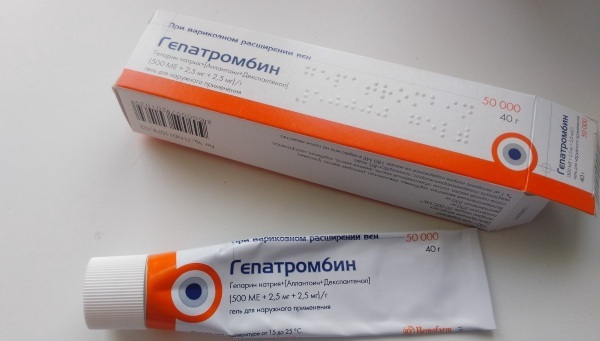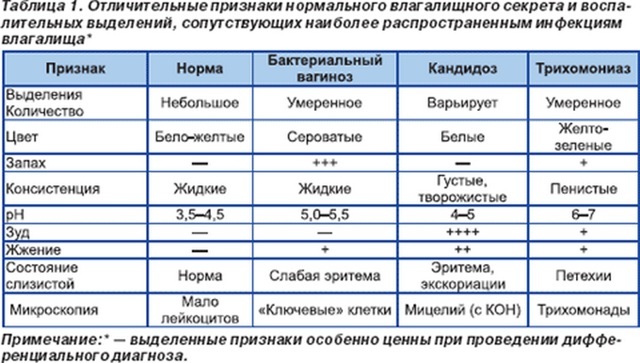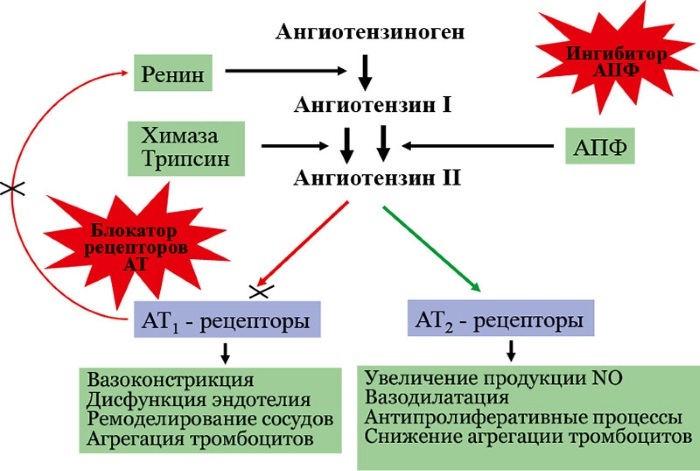Content
- Definition of disease
- Causes of the disease
- Symptoms
- Classification and stages of development
- Diagnostics
- Laboratory Methods
- Instrumental methods
- Differential diagnosis
- Treatment of infectious mononucleosis
- Complications
- Forecast
- Video about infectious mononucleosis
Mononucleosis refers to pathologies of infectious etiology. The patient is prescribed a blood test (indicators often have deviations from the norm) and pharyngoscopy. Pathology is diagnosed in children, adolescents and adults; in the absence of adequate treatment, the risk of complications increases.
Definition of disease
Mononucleosis (a blood test, the indicators of which are deciphered by a doctor, is given in the first place) is called benign lymphoblastosis. The first records of the disease date from 1883. Infectious mononucleosis was detected by pediatrician N. Filatov. M. NS. Epstein and I. Bar in 1964 identified the causative agent of the pathology.
The lymphotropic virus has an adherence (tropism) to the lymphocyte receptors CD2.1 DNA is a double-stranded, lipid-containing envelope includes a nucleocapsid.
There are several main antigens:
- membrane;
- early;
- nuclear;
- capsid.
The virus can persist for a long time in the human body. It is resistant to temperature extremes, ultraviolet light and disinfectants.
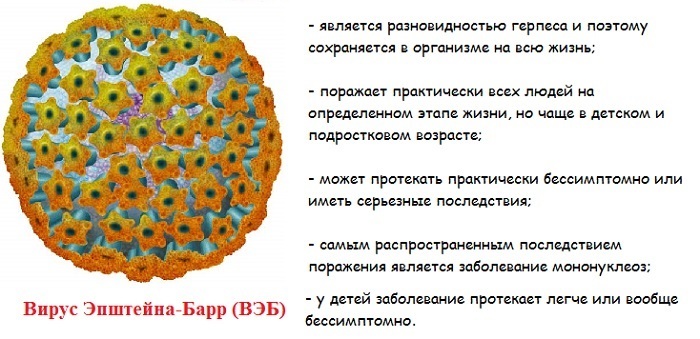
Infectious mononucleosis is mainly transmitted:
- transplacentally (vertically) - from mother to fetus;
- hemocontact - during blood transfusion and other medical procedures;
- contact - mainly during kissing;
- airborne droplets - when sneezing, talking, coughing.
The incubation period of infectious mononucleosis is 2-6 weeks. After infection, a person intensively releases the virus into the environment along with saliva for 1.5 years. Most often, the disease is diagnosed in children 10-16 years old. The nature and intensity of manifestations directly depends on the age of the patient. In children and adolescents, pathology can be asymptomatic.
Mononucleosis is understood as an acute viral infection, which is characterized by damage to the lymph nodes, liver, spleen and nasopharynx. After infection, atypical mononuclear cells are found in the patient's blood. Disease outbreaks are independent of the season. People over 45 years of age rarely get sick. HIV-infected patients are at risk.
Causes of the disease
The causative agent of the disease penetrates the upper respiratory tract and affects the epithelial tissue of the nasopharynx. The pathology is characterized by a moderate inflammatory process. The virus, together with the lymph, enters the lymph nodes, provoking the development of lymphadenitis. The pathogen also enters the systemic circulation, affecting b-lymphocytes.
As the disease progresses, cell deformation is observed. Specific reactions are formed in the body. The virus is able to enter the systemic circulation. Together with the blood, it enters the cells, affecting the entire body. Infectious mononucleosis can be attributed to AIDS-associated pathologies. It is impossible to completely recover from the disease.
The pathogen can parasitize in the human body throughout life. Outbreaks of the disease caused by a decrease in natural defenses are periodically possible. Herpesvirus does not initiate the death of b-lymphocytes. The pathogen can also provoke Burkitt's carcinoma and lymphoma.
The source and reservoir of infection is considered to be an infected person. Most often, the method of transmission of the disease is contact or airborne droplets. Infectious mononucleosis can be transmitted to a healthy person from a sick person during sexual intercourse.
Symptoms
Mononucleosis (blood test, indicators are presented later in the article) is considered a viral disease.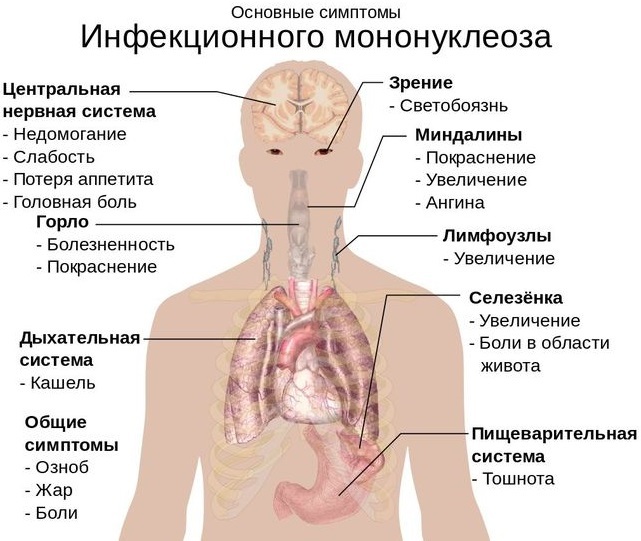
The following symptoms are characteristic of pathology:
- yellowness of the skin;
- rash, redness;
- enlargement of the spleen and liver;
- inflammation of the tonsils of the palate and pharynx;
- enlarged lymph nodes;
- disability;
- decreased appetite;
- weakness;
- joint and muscle pain;
- sleep disturbance;
- excitation;
- apathy;
- lingering headache.
The incubation period is 5-45 days. Patients sometimes complain of malaise and weakness. Symptoms become more pronounced as the disease progresses. Temperature changes, runny nose, sore throat are possible. The tonsils are enlarged, the mucous membrane of the oropharynx swells and turns red. If the disease is acute, then patients have severe headache, increased sweating, chills and fever.
Sore throat worsens, fever persists for 2-3 weeks. The main symptom complex develops 7-10 days after infection. Hepatosplenomegaly, lymphadenopathy, tonsillitis are noted. General signs of poisoning may appear.
The patient's well-being is rapidly deteriorating, in the throat there is a manifestation of follicular, filmy, necrotic or catarrhal sore throat. The mucous membrane of the tonsils is inflamed, a loose yellow coating appears on it. The back of the pharynx becomes granular.
Polyadenopathy occurs 2-5 days after infection. Lymph nodes enlarge in the jaw and neck area. On palpation, they are mobile and dense. Enlargement of the spleen and liver indicates the progression of the disease. Patients note yellowness of the skin and sclera. There are complaints of darkening of urine and dyspepsia. A rash may appear on the skin, accompanied by itching and burning.
After 2-3 weeks, the outbreak of mononucleosis subsides. The patient's temperature returns to normal, the spleen and liver return to normal. Angina ceases to bother. In the absence of adequate treatment, infectious mononucleosis becomes chronic. Outbreaks in this case are observed for 2 years. Adults tolerate the disease more easily.
Classification and stages of development
Infectious mononucleosis by clinical forms can be divided into atypical and typical.
Classification of pathology by severity:
- toxic;
- medium;
- easy.
Downstream classification of mononucleosis:
- complicated;
- uncomplicated.
There are several main forms of atypical mononucleosis:
- asymptomatic;
- erased;
- specific;
- exanthemic;
- icteric.
Asymptomatic is characterized by the absence of signs of infection. With erased mononucleosis, symptoms are mild. The specific form is characterized by the absence of one of the main syndromes (for example, angina, hepatosplenomegaly). The exanthemic form of mononucleosis develops against the background of prolonged use of aminopenicillin antibiotics. For icteric, there are signs indicating damage to the biliary organ.
Diagnostics
Mononucleosis (blood test, serological test indicators require a specialist decoding) can be detected at the initial stage.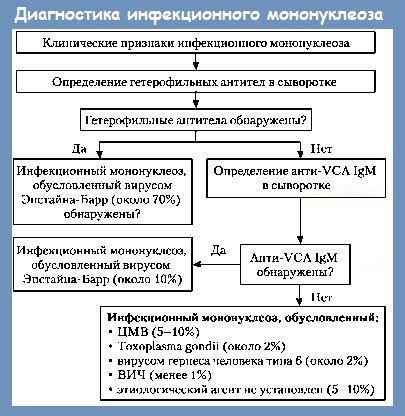
Diagnostics includes several basic methods:
- laboratory;
- instrumental;
- differential.
A complex of diagnostic measures allows you to identify pathology at an early stage.
Laboratory Methods
The laboratory method of research involves the donation of venous blood for analysis. For infectious mononucleosis, PCR and a serological test are taken. To get the most accurate results, you need to properly prepare for the examination.
Adult patients are prohibited from drinking alcohol 24-48 hours prior to the proposed study. Children under 1 year of age are not given breast milk or adapted formula for 40 minutes. before blood sampling. Children under 5 years of age should not be fed 3 hours before the intended examination. Adults should not eat 78 hours prior to blood sampling.
The use of non-carbonated pure water is allowed. It is forbidden to take any drugs that can distort the results of the analysis. During blood sampling, the person should be emotionally calm. You cannot smoke for 30-45 minutes. before blood sampling.
A general blood test allows you to exclude all causes of mononucleosis, except for the transmission of the pathogen from a sick person to a healthy one. It must be remembered that mononuclear cells, lymphocytosis and leukocytosis can also be observed in people suffering from other diseases of infectious etiology.
To confirm or refute the doctor's suspicion, you need to conduct a comprehensive study of biomaterials.
Most often, patients are referred to the laboratory when the following symptoms appear:
- hepatosplenomegaly;
- lymphadenopathy;
- acute sore throat;
- arthralgia;
- myalgia;
- weakness;
- fever.

Decoding the results:
| PCR | EA IgG | EBNA IgG | VCA IgM | Venous blood analysis | |
| Mononucleosis | + | + | — | + | Mononuclear cells, lymphocytosis, leukocytosis. |
| Previous infection | — | — | + | — + | Without changes |
| Latent mononucleosis | + — | + — | ++ | — | Without changes |
The final result can affect the general state of the patient's immunity.
Instrumental methods
Mononucleosis (blood test, virological test indicators make it possible to determine the stage of the pathology course) is also detected by means of instrumental diagnostic methods.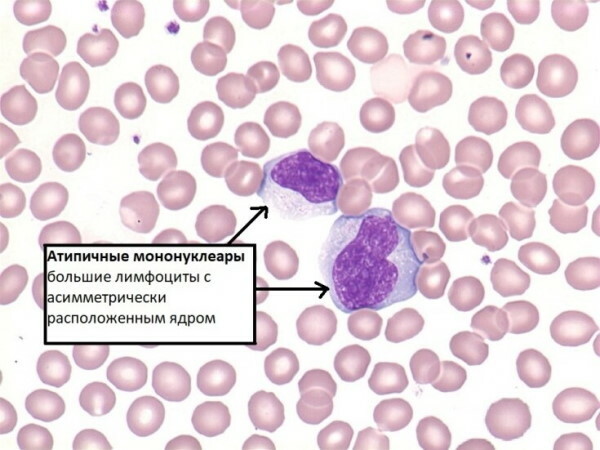
If you suspect infectious mononucleosis, the doctor prescribes a number of instrumental studies:
- Electrocardiogram. Patients with tonsillitis are referred to it during an exacerbation of chronic infectious mononucleosis. The ECG allows you to detect a violation of the functional activity of the cardiovascular system.
- Radiography. It is prescribed for patients with catarrhal tonsillitis during an exacerbation of chronic infectious mononucleosis. X-rays help to trace and identify degenerative changes in the lungs.
- X-ray of the paranasal sinuses. The procedure is prescribed for patients with catarrhal tonsillitis and chronic mononucleosis. X-rays help confirm or deny the diagnosis.
The patient may also be prescribed an abdominal ultrasound. The procedure is performed to assess the condition and size of the spleen and liver.
Differential diagnosis
Primary HIV infection resembles acute infectious mononucleosis.
If the patient is at risk, then he needs to undergo a series of tests:
- combined immunoassay for antigens and antibodies;
- determination of the quantitative load of HIV RNA in the blood. An HIV immunosorbent test shows a negative result if infectious mononucleosis develops in the patient's body. Determination of antibodies, antigen and HIV RNA test are considered more reliable methods.
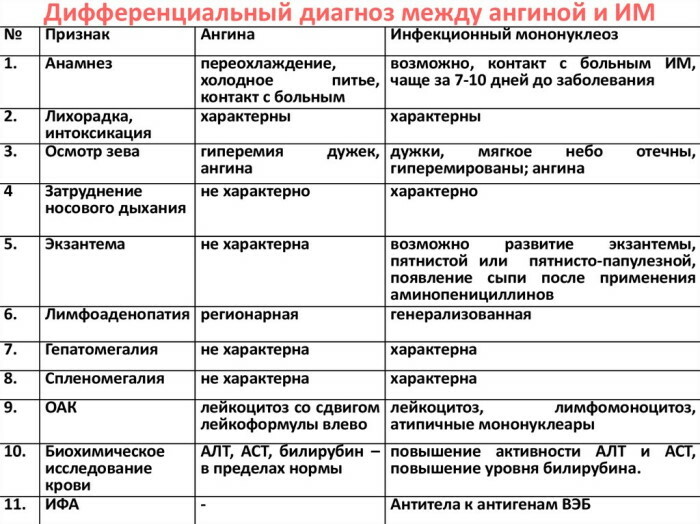
Differential diagnosis allows you to exclude a number of pathologies. Cytomegalovirus has a similar symptom complex with infectious mononucleosis. Patients may complain of hepatosplenomegaly and lymphocytosis. Pharyngitis is not typical for cytomegalovirus. Toxoplasmosis is also characterized by lymphadenopathy and fever, but, unlike mononucleosis, pharyngitis does not develop against the background of toxoplasmosis.
Treatment of infectious mononucleosis
Mononucleosis requires medication. A blood test and other indicators allow you to determine the clinical picture of the disease. The specialist selects a comprehensive treatment.
For infectious mononucleosis, the following categories of drugs are used:
- antibiotics;
- antiviral;
- antipyretic;
- interferons;
- detoxification.
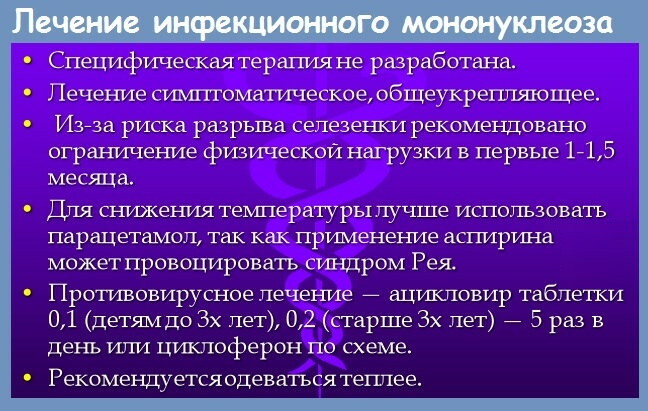
Antibiotics for the treatment of mononucleosis:
- Sumamed. The drug has several forms of release: powder for suspension, lyophilisate, tablets, capsules. The active ingredient is azithromycin. The antibiotic belongs to the macrolide group. Active against beta-hemolytic, anaerobic bacteria. It can be included in the complex therapy for mononucleosis, accompanied by tonsillitis, bacterial lesions of the lungs, sinusitis. The dosage regimen is selected individually. Long-term use may be needed.
- Ampicillin. Dosage form - suspension, lyophilisate, capsules, tablets. The active ingredient is ampicillin in the form of trihydrate. The drug has an antibacterial effect. The antibiotic belongs to the penicillin group. It is active against gram-negative and gram-positive bacteria. Effective for sinusitis and tonsillitis. With prolonged use, side effects may occur. The dosage regimen is selected individually.
-
Amoxiclav. The drug is marketed in the form of a powder for the preparation of suspensions, capsules and tablets. The active ingredient is amoxicillin in the form of trihydrate. The antibiotic of the penicillin series is active against gram-negative and gram-positive bacteria. It can be used for tonsillitis and sinusitis as an adjuvant. There are contraindications. With prolonged use, there is a high risk of side effects. The reception scheme is selected individually.

Antiviral drugs:
- Amiksin. The drug is marketed in pill form. The active ingredient is tilorone. Accessories may vary depending on the manufacturer. The drug has an immunomodulatory and antiviral effect. The medication can be included in the complex therapy for infectious mononucleosis. The drug is not prescribed for children under 7 years of age. There are contraindications. The doctor selects the scheme of application depending on the type of pathology.
- Lavomax. The drug is marketed in tablets. The active ingredient is tilorone in the form of hydrochloride. The drug has a pronounced antiviral effect. There is also a slight immunomodulatory effect. With infectious mononucleosis, Lavomax can be included in drug therapy. The drug is not prescribed for children. There are absolute contraindications. Side effects are indicated in the instructions. The doctor selects the regimen individually.
- Nobazit. The drug has a pronounced antiviral effect. It is marketed in tablet form. The active ingredient is enisamia iodide. The medication has an interferonogenic effect, increases the body's resistance to viruses. The drug can be included in the complex therapy for infectious mononucleosis. With regular use, it reduces the severity of the symptoms of the disease. The drug has contraindications. The dosage regimen is selected individually.
Temperature-lowering drugs:
- Ibuprofen. Release form - gel, ointment, tablets, suspension and suppositories. The active element is the substance of the same name. Additional components may vary depending on the formulation. The medication has an antipyretic effect, anti-inflammatory and mild analgesic effect. It relieves the symptoms of the fever. The drug has contraindications. Side effects may occur. The dosage regimen is selected individually.
- Paracetamol. The drug is sold in pill form. The active substance is the component of the same name. The medication has antipyretic and analgesic effects. It can be included in the complex therapy for mononucleosis. The drug has contraindications. The reception mode requires individual selection.
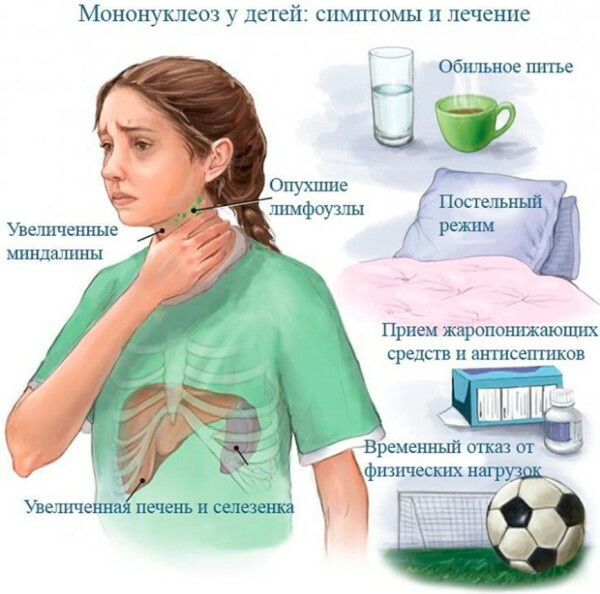 It is strictly forbidden to independently draw up a treatment regimen. Therapy is prescribed only after a complete examination.
It is strictly forbidden to independently draw up a treatment regimen. Therapy is prescribed only after a complete examination.
Complications
With mononucleosis of an infectious type, damage to most organs and systems is observed. In the absence of adequate treatment, the risk of complications is quite high. If the patient does not follow the doctor's instructions, the spleen may rupture. A complication arises against the background of an increase in pressure on the walls. The rupture is often accompanied by profuse internal bleeding. The patient experiences acute pain in the peritoneal region, dizziness. Coma is possible.
Complications against the background of mononucleosis also include a secondary bacterial infection (tonsillitis, bronchitis, sinusitis). Antiviral, antipyretic drugs should be included in the drug therapy. Infectious mononucleosis is characterized by enlargement of the palatine and pharyngeal tonsils. Dense lymph nodes block the airflow and the patient suffers from breathing difficulties.
Hepatitis is considered a complication resulting from infectious mononucleosis. The pathological condition is characterized by yellowing of the mucous membranes of the sclera and skin. A blood test reveals elevated bilirubin. Meningitis, as a complication after infectious mononucleosis, is rarely diagnosed in patients. The condition is characterized by persistent vomiting, nausea, and headache. Children often have seizures.
Complications of the hematological type appear due to a decrease in hemoglobin. The condition develops against the background of a weakening of the body's defenses.
Forecast
A mild degree of infectious mononucleosis is characterized by a favorable outcome. The disease goes away rather quickly. The exacerbation lasts 10-14 days. There are few deaths from the disease - no more than 0.8%. The main reason is complications arising from the lack of adequate treatment (pulmonary obstruction, spleen rupture, meningitis). Preventive measures against infectious mononucleosis include personal hygiene, sports, and the introduction of a correct lifestyle.
Mononucleosis is a dangerous disease. If you suspect a virus, you must immediately take a blood test (the indicators will be deciphered by a doctor), a PCR test and an additional examination. During treatment, the patient must comply with bed rest.
Video about infectious mononucleosis
Komarovsky about infectious mononucleosis:

